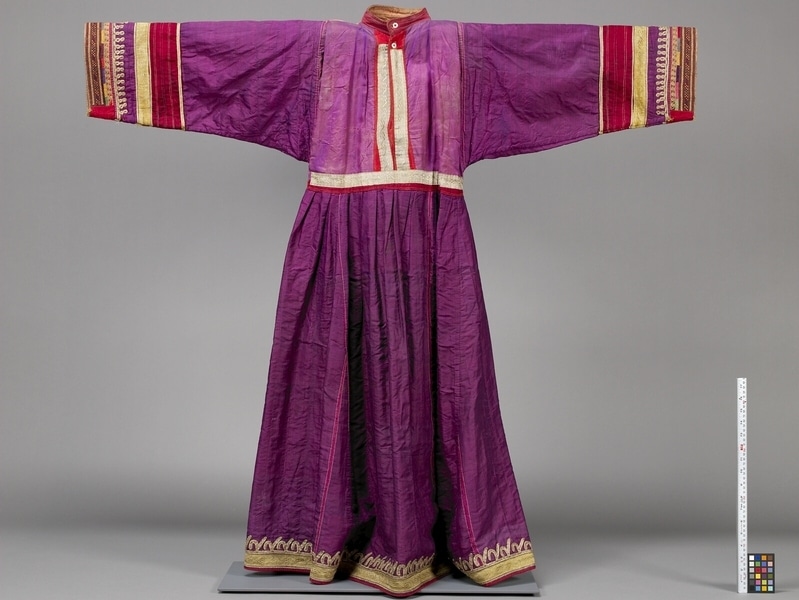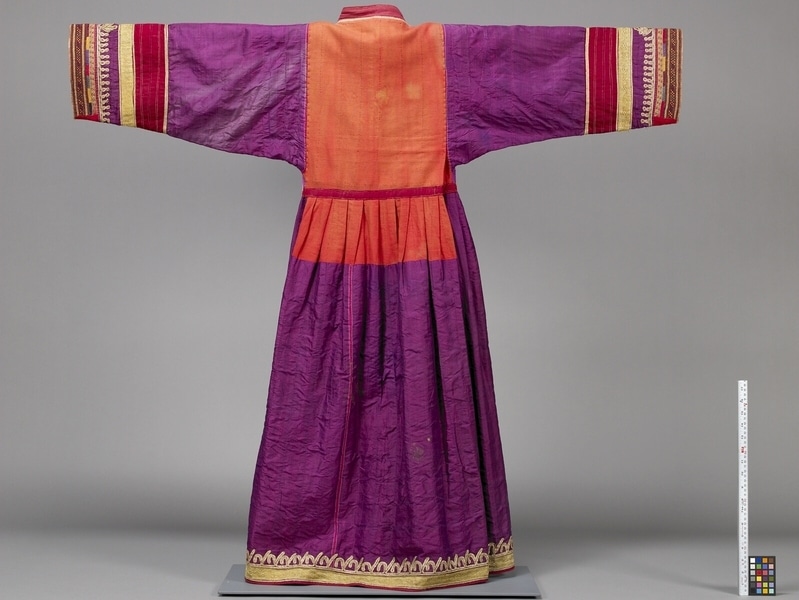Dress Item Number: Ea4 from the MOA: University of British Columbia


Description
Woman’s dress made of purple shot silk, trimmed with gold jacquard ribbon, gold braid and panels of red cotton textile, closed at the neck with two white glass buttons. The neckline is finished with a narrow collar band. The wide cuffs are trimmed with gold braid and small, geometric embroidery. The back of the bodice and the upper part of the skirt are made of orange cotton textile. The waistband is constructed of gold jacquard ribbon and red cotton textile. The full skirt is pleated onto the waistband, and the hemline is trimmed with couched gold braid designs and gold jacquard ribbon. Completely backed with pink cotton textile; the lining and outer textiles are stitched together at intervals with a running stitch.
History Of Use
Worn with loose-fitting pants and a shawl for special occasions, e.g., weddings.
Specific Techniques
Iridescent shot effect in fabric achieved by using a weft that differs from the warp colour. Pleating is often found on Afghanistan ceremonial clothing.
Narrative
The dress appears to be Pashtun or Hazara, according to examples in the published literature, however the dress was identified as Baluchi by the previous owner. Because of the elegant fabric used to make this dress, it is reasonable to assume that it was made and worn by urban-dwellers rather than nomads.The dress was said to have been worn by the mother of a bride at a wedding.
Iconographic Meaning
The repeated pattern at the hemline may represent peacocks, symbolizing fertility.
Item History
- Made in Afghanistan before 1973
- Collected in Afghanistan during 1973
- Owned by Mrs. Chris Ginfrida before June 10, 1976
- Received from Mrs. Chris Ginfrida (Seller) and Museum of Anthropology Donations Fund (Funding source) on June 10, 1976
What
- Name
- Dress
- Identification Number
- Ea4
- Type of Item
- dress
- Material
- silk fibre, cotton fibre, rayon fibre ?, glass, dye and metal
- Manufacturing Technique
- embroidered and sewn
- Overall
- height 128.0 cm, width 132.2 cm
Who
- Culture
- Baluchi ?
- Previous Owner
- Mrs. Chris Ginfrida
- Received from
- Mrs. Chris Ginfrida (Seller) and Museum of Anthropology Donations Fund (Funding source)
Where
- Holding Institution
- MOA: University of British Columbia
- Made in
- Afghanistan
- Collected in
- Afghanistan
When
- Creation Date
- before 1973
- Collection Date
- during 1973
- Ownership Date
- before June 10, 1976
- Acquisition Date
- on June 10, 1976
Other
- Item Classes
- textiles
- Condition
- good
- Accession Number
- 0308/0004